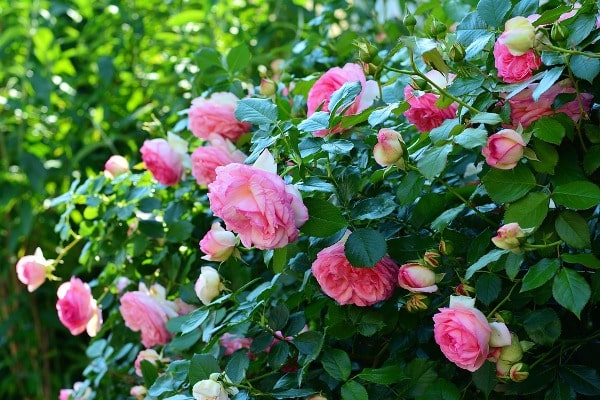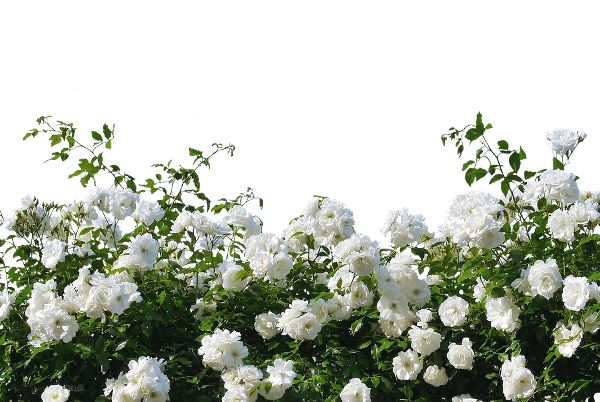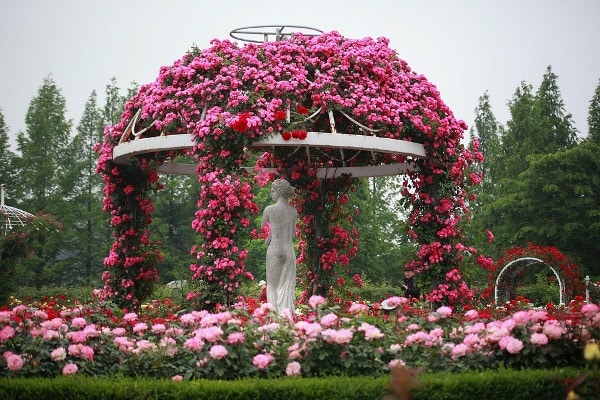Rose Plantation Profit, Project Report – A Beginner Guide:
Today, let us go through Rose Plantation Cost, and Cut rose growing procedure.
Roses are the best commercially grown flowers all over the world. This ranks on top in global flower trade. The worldwide consumption of roses is more than 40 billion. The rose is the most favorite flower and regarded as “King of flowers”. Roses have heavy demand for rose cut flowers in the European countries from November to March.
There are many species and varieties of roses, and they have various uses. Roses are used as cut flowers and garden plants. Roses are also used for making rose oil, rose water and gulkhand. They are used for in the preparation of bouquets, floral arrangements, worship, events/functions and are used as gifts. In the international market, there is a huge demand for cut roses.
Rose cultivation is mainly based upon the types of land. The roses we cultivated are not as per the international standards. The plant density we get is very low (8000-15000/ha) as per field analysis. We don’t implement all the scientific methods for farming and post-harvest methods. And we don’t implement any marketing techniques and we don’t encourage our product exports. The main reason for this situation is, all the rose growers are small and medium farmers, who don’t have enough investment for the proper production of the plant.
In western countries, they implement all the scientific methods for cultivating roses, and produced high yield, and have a highly valued market standard.
An opportunity for development of cut roses (and other cut flowers) arose in the countries of the southern hemisphere, such as Columbia, Mexico, Kenya, and Zimbabwe. The scope of cultivation has increased by the introduction of rose varieties which are cultivation even under high temperature. For the cut roses, the market has remained static, and new centers of rose production under low-cost plastic Greenhouses are introduced in the countries of the southern hemisphere to export to the countries of the northern hemisphere, where there is huge demand for cut roses, and demand is increasing at the rate of 9% per annum.
Considering the developments and the economic liberalization farmers are showing interest in the production of cut roses in plastic greenhouses in India also.
Cut Roses Plantation Business:

Commercial production of cut flowers can be, good startup considering market demand and implementing proper marketing methods you can make it a profitable venture.
Climatic Requirements and Soil for Cut Rose Plantation:
- These Plantations require a good amount of sunlight.
- And they grow well in humid and moderate temperature ranging from 15 °C to 28 °C can be the ideal temperature for roses in the tropical and subtropical climate of India.
- Rose plants required well drained soil rich in organic matter and good aeration in the soil produce a greater number of roses.
- The Organic matter in the soil should be more than 20 per cent.
- The pH levels of the soil should be around 6 to 6.5.
Land Requirements for Cut Rose Plantation:
Before selecting a suitable land for Plantation, you should consider the following features.
- Production Cost.
- Quality of flowers.
- Transportation cost.
The land you choose, should be selected based on the above features and it should be capable of producing a high-quality flower at low cost and that can stand up to international competition. As per the floriculture expert committee by the Ministry of Commerce, Government of India, has identified the below places are perfect for the rose plantation to the production of cut roses for export purposes.
- In and placed around Hyderabad.
- In and placed around Bangalore.
- Nasik, Pune and some places around these places.
Export Standard for Rose Plantation:
For starting an export-oriented project you must adopt innovative technology as per the requirement of the overseas market. The main requirement of the export oriented, innovative technology are suitable varieties, that are popular in the overseas markets, ultrahigh planting density, using the greenhouse, maintenance of grades and quality innovative technology.
Rose Varieties:
The major types of roses are commercially grown are:-
- Hybrid Tea Roses: these roses are large flowers (about 4 cm.) with long stems (about 125 cm). The plants yield varies from 100-200 stems/sqm. These roses have a higher price than other types. Some popular varieties of hybrid tea roses are SONIA, VIVALDI, TINEKE, MELODY, DARLING and ONLY LOVE.
- Floribunda Roses: this variety roses are small flowers (about 2.5 cm) and they have shorter stems (less than 60 cm), these plants produce higher yields than other types. Some types of floribunda roses are FRISCO, MERCEDES, JAGUAR, KISS and FLORENCE.
- Spray Roses: these plants have a single stem of this type, and produce 5-6 flowers, the production of roses of these plants are low. Some popular varieties belonging to the Spray roses type are EVELIEN, JOY and NIKITA.

Greenhouse For Rose Plantation:
In general, Greenhouse is structurally covered with a transparent material which permits a good amount of natural light for plant growth. Greenhouses are the good choice for production of good quality cut roses without blemishes.
Layout And Planting Requirement Of Rose Plantation:
You should follow a certain layout and planting procedure for producing high quality roses.
- The plants should be planted on two rows of plants per bed.
- The roots of the planted should be kept well aerated and kept clear of standing water.
- The Plant density should be 50,000 to 60,000 plants per hectare.
- The ideal period for planting rose plants can from February to April and/or from July to November.
Manure for Rose Plantation:
you should prefer organic manures for rose plants, add organic manure should be added up to 30 cm on of the soil. Make sure that the soil has 30% organic matter content.
Fertilizer requirement for Rose Plantation:
The use of nutrients should be based on an analysis of soil and plant requirement. Application of Nitrogen, Potassium and Phosphorous is compulsory along with other nutrients is applied during the budding period.
Read: Frequently Asked Questions About Fertilizers.
Irrigation and Draining systems in Rose Plantation:
For rose plants, we need a lot of water, the minimum requirement is 6mm / day. For proper irrigation, you need to design a drip system to deliver the above quantity of water should be present.
Drip system design for Rose Plantation:
- Set up the main line along with Sub – Main Line and a lateral line in between two rows.
- The drainage line should be laid below the beds for disposal of excess water.
Importance Pruning in Rose Plantation:
Pruning plays a key role in rose Plantation. The stems should be pruned, leaving 4-5 nodes on the basic stock frame, you also need to prune all weak shoots and redirecting the wayward ones. Pruning should be done in a phased manner so that flowering takes place from September to March. Generally, the flowering period will be 45 days after pruning.

Pests And Diseases In Rose Plants:
The main pests that damage the rose Plantation are
- Red spider mite
- Leafrollers
- Whiteflies
- Thrips
- Aphids
- Nematode
The diseases that damage the rose Plantation are:
- Powdery mildew
- Downy mildew
- Botrytis
- Pruning die back
- Black leaf spot
Read: Frequently Asked Questions About Plant Diseases.
Preventive Measure to Control pests and diseases in Rose Plantation:
The best preventive measure is, Use spray mixed below chemicals, use this spray once in a week.
Make the spray with
- Dithane
- Metasystox
- Karathane.
Harvesting the Roses:
The post-harvest work will start after harvesting. Roses should be harvested only at a right stage. The roses should be picked just as the buds starts opening, after the sepals have almost fully curled up and the color is fully visible. In case small flowered rose varieties and Floribundas, the flowers should be harvested when they begin to open the cluster. The harvesting should be done in the evening or early morning with a long stem. The lower end of the harvested stems should be placed immediately in clean plastic buckets containing a preservative solution. Then they are sent to the grading and packing hall.
Packing of Roses:
After harvesting the roses should be immediately graded, packed, precooled and dispatched. If grading and packing is not done immediately, the roses should be shifted to the cold store.
Presentative Solution for Packing Roses:
After hydrating the roses, then they are shifted to the preservative solution. Thereafter flowers are shifted to cold storage. Roses are stored for 4-5 days in a preservative solution in cold storage.
The Preservative solution is a composition of:
- Citric acid.
- HQC/captan.
- Sucrose.
- STS.
- Cytokinin.
Grading of Roses:
Grading of roses is done based upon their quality, grading is done using a mechanical grader or by hand grading tables or work stations.
Packing of Roses:
Packing is a key step, it is a three step process, like bunching, wrapping and packing.
- The heads of roses are tied, and stems are packed with a rubber band in bunches (a bunch can have 10, 20 or 30 roses based on your order). Make sure that all stems are of the same length. The bunches move into preservative solution and they can be shifted to the cold store if needed.
- In wrapping, all the buds are wrapped and the bunches are sleeved in transport polyethylene cover. The wrap is about 15-20 cm.
- Now packing is done with cardboard boxes. In case of long-term transport telescopic style boxes made of corrugated fiberboard can be a best option. The size of the boxes can of 100 cm x 45 cm x 22 cm.
Storing Procedure of Roses:
After packing and grading, roses are stored in cold storage before you market or export. The cold storage temperature should be as below.
In case of wet storage: If storing 4 to 5 days, the storage temperature should 0.5 °C to 20 °C.
In the case of Dry storage: if storing for more than 15 days, the storage temperature should 0.5 °C to 00 °C.
Transportation of Roses:
The cut roses from fields should be transported overnight. And many varieties of roses don’t have life span more than 7 days. The transportation of roses from the field mainly depends on the distance to the local market and if the roses are exported, they should be transported in a refrigerated van.
The temperature of the van should be around 2 – 40 °C.
Cut Rose Plantation Project Report:
- Land: Acquire a land that’s near to market, and soil should be rich in organic matter.
- Greenhouse/Polyhouse: A Plastic Greenhouse is a Low-Cost Structure. A Steel frame greenhouse will stay strong In the long run, a plastic cover will be for 2-3 years
Planting Material: Contact a reputable plant supplier, selects 6 months old grafts of popular rose varieties.
Irrigation System: For good quality roses, you need to implement a proper irrigation system, for that, you need to (1) maintain an overhead tank (2) install a drip irrigation system with a pump set, pressure valves, and piping. - Draining System: If the beds frequently irrigated, you need a build a proper drainage, with a surface drainage system. The plot on which the project is based is completely on the budding system and hence drainage of excess water can be naturally made into availability.
- Grading and Packing Room: For grading and packing of harvested roses, you need a room with cemented floor and roof of a corrugated shed and open on three sides
- Equipment: All the materials and equipment’s can be locally procured and are easily available.
Investment Required for Cut Rose Plantation:
Cost for Structures:
- Estimated cost for Grading or packing room- it can pucca room the cost for construction can be upto Rs. 50,00 to 10,000.
- Cost of building Greenhouse: can upto 2 Lakh to 3 Lakh.
- Fencing cost can be upto Rs. 20,000 to 30,000.
- Cost for constructing darning systems: 20,000 to 25,000.
Equipment and Irrigation Systems cost:
- A Drip Irrigation can cost upto Rs 50,000 to 60,000.
- GENSET can cost upto: Rs 5,000 to 6,000.
- Other machinery like a telephone can cost upto: Rs 5,000 to 6,000.
- Furniture and stationery: Rs. 10,000 to 15,000.
Rose Planting Material Cost:
The cost of 6 months old rose plant grafts cost: can cost up to 5 Lakh.
Rose Plantation Management Cost:
- Office Setup: May cost upto Rs. 2 Lakh.
- Transportation cost: upto Rs. 2 Lakh.
- Labor Charges: Upto 2 to 3 Lakh.
- Marketing Expenses: upto 2 to 3 Lakh.
Rose Plantation Cultivation Cost:
Land preparation and layout: Rs. 30,000 to 50,000.
Manure cost: Rs. 20,000 to 40,000.
Fertilizer cost: Rs. 60,000 to 1 Lakh.
Pesticides: Rs 60,000 to 70,000.
Electricity cost: Rs. 10,000 to 15,000.
Labor cost: Rs. 30,000 to 40,000.
Post-Harvest Cost of Rose Plantation:
Chemical and Preservatives: Rs. 20,000 to 40,000.
Cold storage expenses: Rs 25,000 to 30,000.
Packing Materials: Rs 5,000 to 10,000.
Transportation cost: Rs. 70,000 to 1 Lakh.
Miscellaneous Expenses:
Insurance cost: Rs 1 Lakh to 5 Lakh.
The Conclusion of Rose Plantation: As per the survey, In India, about 4330 ha. Area, producing more than 900 million stems valued at Rs.50.00 crores, is under rose cultivation in the states of Tamil Nadu, Karnataka, Maharashtra and West Bengal.
Read: Growing Safed Musli, Planting Farming Guide.
Do anyone has training for flower plantation in Maharashtra near Pune??